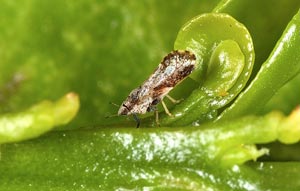Deadly pest found in county citrus tree
Local and state officials address arrival of deadly citrus tree pest

Asian Citrus Psyllid. Image from Wikipedia.
The detection of an adult Asian Citrus Psyllid in an insect trap in a residential landscape near Arroyo Grande has prompted a high density trapping delimitation survey of the immediate and adjacent area. A quarantine restricting the movement of citrus nursery stock and citrus fruit will be established by the California Department of Food and Agriculture to prevent the spread of this serious plant pest. Efforts will take place in the near future to eradicate this pest.
The first detection of the Asian Citrus Psyllid in California occurred in San Diego County in 2008. Since then, it has been found throughout southern California. “This insect pest is of serious concern to California’s commercial citrus because it is responsible for spreading Huanglongbing, also called citrus greening disease, a plant disease that is fatal to all types of citrus trees. This includes citrus trees in countless landscapes across the county as well as local commercial citrus orchards valued at over $13 million in 2013,” according to Martin Settevendemie, Agricultural Commissioner/Sealer for San Luis Obispo County.
Over the past ten years nearly 50% of the commercial citrus groves in Florida have been killed by this disease. The University of Florida estimates the disease has tallied more than 6,600 lost jobs, $1.3 billion in lost revenue to growers and $3.6 billion in lost economic activity for the state. The disease does not affect human health.
A single orange tree infected with Huanglongbing was found in a Los Angeles County backyard in 2012. To date no additional detections of the disease in California have occurred.
Staff from the San Luis Obispo County Agricultural Commissioner’s office and officials from the California Department of Food and Agriculture continue to search for this pest by monitoring hundreds of insect traps placed in urban neighborhoods and commercial orchards throughout the county.
“It is difficult to close off all potential pest pathways into the county. An engaged community of all county residents is critical in successfully excluding pests such as Asian Citrus Psyllid,” said Settevendemie. Community members can do the following to protect backyard citrus trees and the local citrus industry:
Buy Local! Purchase citrus trees from reputable local sources selling plants that have been routinely inspected by the Agricultural Commissioner’s staff.
Do not transport citrus plants or plant parts into the county from quarantine areas. Call 805- 781-5910 for information about quarantine areas.
Check residential landscaping often for signs of unusual symptoms or strange insects.
Contact the local University of California Cooperative Extension’s Master Gardener Program at 805-781-5939 for help in identification of unusual plant symptoms or pests.
If asked, allow the Agricultural Commissioner’s staff to place an insect trap in your yard and cooperate with officials if it becomes necessary to exclude or eliminate Asian Citrus Psyllid from San Luis Obispo County.
For more information about the Asian Citrus Psyllid visit the California Department of Food and Agriculture website at http://www.cdfa.ca.gov or the San Luis Obispo County Agricultural Commissioner/Sealer’s website at: http://www.slocounty.ca.gov/agcomm/Pest_Prevention.htm.



















